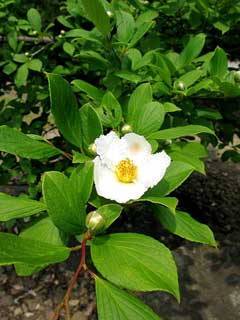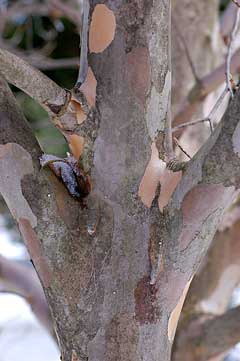 |
|
http://commons.wikimedia.org/wiki/User:Qwert1234 |
 |
| http://en.wikipedia.org/wiki/User:Ram-Man |
Translate this page:
Summary
Bloom Color: White. Main Bloom Time: Early summer, Late summer, Mid summer. Form: Oval, Pyramidal.
Physical Characteristics

 Stewartia pseudocamellia is a deciduous Tree growing to 15 m (49ft) by 8 m (26ft) at a slow rate.
Stewartia pseudocamellia is a deciduous Tree growing to 15 m (49ft) by 8 m (26ft) at a slow rate.
See above for USDA hardiness. It is hardy to UK zone 5. It is in flower from July to August. The species is hermaphrodite (has both male and female organs) and is pollinated by Insects.
Suitable for: light (sandy), medium (loamy) and heavy (clay) soils. Suitable pH: mildly acid and neutral soils. It can grow in semi-shade (light woodland) or no shade. It prefers moist soil.
UK Hardiness Map
US Hardiness Map
Synonyms
Stuartia pseudocamellia. Maxim.
Plant Habitats
Woodland Garden Canopy;
Edible Uses
Edible Parts: Leaves
Edible Uses:
Young leaves - cooked[177].
References More on Edible Uses
Medicinal Uses
Plants For A Future can not take any responsibility for any adverse effects from the use of plants. Always seek advice from a professional before using a plant medicinally.
None known
References More on Medicinal Uses
The Bookshop: Edible Plant Books
Our Latest books on Perennial Plants For Food Forests and Permaculture Gardens in paperback or digital formats.

Edible Tropical Plants
Food Forest Plants for Hotter Conditions: 250+ Plants For Tropical Food Forests & Permaculture Gardens.
More

Edible Temperate Plants
Plants for Your Food Forest: 500 Plants for Temperate Food Forests & Permaculture Gardens.
More

More Books
PFAF have eight books available in paperback and digital formats. Browse the shop for more information.
Shop Now
Other Uses
Landscape Uses: Espalier, Pest tolerant, Standard, Specimen, Street tree.
Special Uses
Espalier
References More on Other Uses
Cultivation details
Requires a deep humus-rich moist but not boggy soil[200]. Dislikes limey soils, preferring peaty conditions[11, 200]. Prefers a position with some shade, at least from the midday sun[200]. Another report says that it prefers a sunny sheltered position[11]. Hardy to about -20°c[200]. Resents root disturbance, plants should be put in their permanent positions as soon as possible[11, 200]. Plants in this genus are notably resistant to honey fungus[200]. Special Features:Not North American native, Attractive flowers or blooms.
References Carbon Farming Information and Carbon Sequestration Information
Temperature Converter
Type a value in the Celsius field to convert the value to Fahrenheit:
Fahrenheit:
The PFAF Bookshop
Plants For A Future have a number of books available in paperback and digital form. Book titles include Edible Plants, Edible Perennials, Edible Trees,Edible Shrubs, Woodland Gardening, and Temperate Food Forest Plants. Our new book is Food Forest Plants For Hotter Conditions (Tropical and Sub-Tropical).
Shop Now
Plant Propagation
Seed - best sown as soon as it is ripe in a cold frame or in an outdoor seedbed if there is sufficient seed[78]. Stored seed is best soaked for 3 days in warm water and then given 3 - 5 months warm stratification followed by 3 months cold stratification at 5°c, it can take 18 months to germinate[78]. Prick out the seedlings into individual pots once they are large enough to handle and grow them on in a cold frame for their first winter. Plant out in early summer. Cuttings of short side branches, 8cm with a heel, July/August in a frame[1, 200]. One report says it is best to keep the cuttings growing through the winter if possible[1] whilst another says they should be allowed to become dormant once they have rooted[200]. Layering.
Other Names
If available other names are mentioned here
Native Range
TEMPERATE ASIA: Japan (Honshu, Kyushu, Shikoku), Korea, South
Weed Potential
Right plant wrong place. We are currently updating this section.
Please note that a plant may be invasive in one area but may not in your area so it's worth checking.
Conservation Status
IUCN Red List of Threatened Plants Status :

Growth: S = slow M = medium F = fast. Soil: L = light (sandy) M = medium H = heavy (clay). pH: A = acid N = neutral B = basic (alkaline). Shade: F = full shade S = semi-shade N = no shade. Moisture: D = dry M = Moist We = wet Wa = water.
Now available:
Food Forest Plants for Mediterranean Conditions
350+ Perennial Plants For Mediterranean and Drier Food Forests and Permaculture Gardens.
[Paperback and eBook]
This is the third in Plants For A Future's series of plant guides for food forests tailored to
specific climate zones. Following volumes on temperate and tropical ecosystems, this book focuses
on species suited to Mediterranean conditions—regions with hot, dry summers and cool, wet winters,
often facing the added challenge of climate change.
Read More
Expert comment
Author
Maxim.
Botanical References
1158200
Links / References
For a list of references used on this page please go here
Readers comment